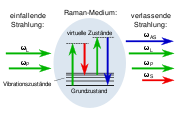Coherent anti-Stokes Raman spectroscopy
- Coherent anti-Stokes Raman spectroscopy
-
 |
Dieser Artikel oder Abschnitt bedarf einer Überarbeitung. Näheres ist auf der Diskussionsseite angegeben. Hilf mit, ihn zu verbessern, und entferne anschließend diese Markierung. |
Die nicht-lineare Raman-Spektroskopie versteht man die nichtlineare spektroskopische Untersuchung der Streuung von Licht an Molekülen oder Festkörpern. Sie nutzt die nicht-lineare Raman-Streuung (engl. coherent anti-Stokes Raman scattering,CARS).
Funktionsweise

Das CARS-Prinzip: Zwei einfallende Laserfrequenzen ωL und ωP erzeugen im Raman-Medium Stokes- bzw. Anti-Stokes-Strahlung der Frequenzen ωS bzw. ωAS.
Der Unterschied zur (linearen) Raman-Spektroskopie besteht in der besonderen Anregungsart, die zwei Laserstrahlen (Pump- und Stokes-Laser) mit geeigneten Frequenzen erforderlich macht. Bei Überlagerung dieser Strahlen entsteht durch die Wechselwirkung von Licht mit Materie ein laserstrahl-ähnliches Signal. Dieses Signal wird resonant verstärkt, wenn die Differenz der Frequenzen der Laserstrahlen einer Raman-Resonanz entspricht. Das Signal erscheint um den Betrag der Raman-Resonanz blauverschoben zum Pump-Laser.
Anwendung
Die CARS-Spektroskopie dient unter anderem zur Untersuchung von Materialeigenschaften, thermodynamischen Eigenschaften (z. B. Temperatur) oder auch zur spezies-selektiven Mikroskopie. Sie wird unter anderem in der Plasma- und Verbrennungsdiagnostik, in der Mikroskopie und zur Qualitätssicherung von Diamanten eingesetzt. Außerdem kann sie bei der Untersuchung biologischer Systeme zur Sichtbarmachung von fast beliebigen wählbaren Molekülarten durch Anregung charakteristischer Schwingungsmodi (CH2-Schwingung für Lipide, Amidschwingung für Proteine, Phosphatschwingung für DNA) genutzt werden, die deshalb nicht erst durch Fluoreszenzfarbstoffe markiert werden müssen.
Literatur
- E. O. Potma, X. S. Xie: Detection of single lipid bilayers with coherent anti-Stokes Raman scattering (CARS) microscopy. In: Journal of Raman spectroscopy. 34, Nr. 9, 2003, S. 642-650 (doi:10.1002/jrs.1045).
Siehe auch
Wikimedia Foundation.
Schlagen Sie auch in anderen Wörterbüchern nach:
Coherent anti-Stokes Raman spectroscopy — Coherent anti Stokes Raman spectroscopy, also called Coherent anti Stokes Raman scattering spectroscopy (CARS), is a form of spectroscopy used primarily in chemistry, physics and related fields. It is sensitive to the same vibrational signatures… … Wikipedia
Coherent Stokes Raman spectroscopy — (CSRS pronounced as scissors ) is a form of spectroscopy used primarily in chemistry, physics and related fields. It is closely related to Raman spectroscopy and lasing processes. It is very similar to Raman spectroscopy but involves a lasing… … Wikipedia
Raman spectroscopy — Energy level diagram showing the states involved in Raman signal. The line thickness is roughly proportional to the signal strength from the different transitions. Raman spectroscopy ( … Wikipedia
Coherent spectroscopy — Spectroscopy is the study of light through light matter interactions. There are three main types of interactions: Quantized interactions in which involved molecules (Here: atoms, full or parts of molecules or crystals,..) jump from a stationary… … Wikipedia
spectroscopy — spectroscopist /spek tros keuh pist/, n. /spek tros keuh pee, spek treuh skoh pee/, n. the science that deals with the use of the spectroscope and with spectrum analysis. [1865 70; SPECTRO + SCOPY] * * * Branch of analysis devoted to identifying… … Universalium
Spectroscopy — Analysis of white light by dispersing it with a prism is example of spectroscopy. Spectroscopy ( … Wikipedia
Raman-Effekt — Illustration von Rayleigh , Strokes und Anti Strokes Streuung Als Raman Streuung (auch Raman Effekt oder Smekal Raman Effekt) wird die inelastische Streuung von Licht an Atomen oder Molekülen bezeichnet. Sie ist nach Chandrasekhara Raman benannt … Deutsch Wikipedia
Raman-Prozess — Illustration von Rayleigh , Strokes und Anti Strokes Streuung Als Raman Streuung (auch Raman Effekt oder Smekal Raman Effekt) wird die inelastische Streuung von Licht an Atomen oder Molekülen bezeichnet. Sie ist nach Chandrasekhara Raman benannt … Deutsch Wikipedia
Raman-Spektroskopie — Unter Raman Spektroskopie (benannt nach dem indischen Physiker C. V. Raman) versteht man die spektroskopische Untersuchung der inelastischen Streuung von Licht an Molekülen oder Festkörpern (Raman Streuung). Sie dient unter anderem der… … Deutsch Wikipedia
Oberflächenverstärkte Raman-Streuung — Illustration von Rayleigh , Strokes und Anti Strokes Streuung Als Raman Streuung (auch Raman Effekt oder Smekal Raman Effekt) wird die inelastische Streuung von Licht an Atomen oder Molekülen bezeichnet. Sie ist nach Chandrasekhara Raman benannt … Deutsch Wikipedia

